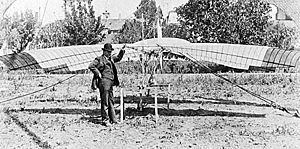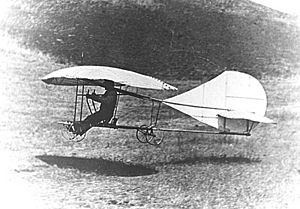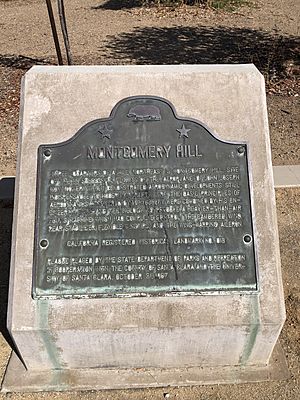John Joseph Montgomery facts for kids
John Joseph Montgomery (born February 15, 1858 – died October 31, 1911) was an American inventor, physicist, and professor. He taught at Santa Clara University in Santa Clara, California. He is famous for inventing and flying controlled machines that were heavier than air.
In the 1880s, Montgomery performed many flight experiments. He used a series of gliders in Otay Mesa near San Diego, California. He first talked about these flights in 1893. Some historians believe his glider experiments were the first controlled flights of a heavier-than-air machine in America.
Montgomery created different ways to control his gliders. In 1884, he used shifting his weight for turning (roll) and a movable tail part (elevator) for going up and down (pitch). Later, in 1885–1886, he added hinged flaps on the wings. These flaps, which the pilot could move, helped with roll control. Even later, from 1903–1905, he used full wing warping systems. This allowed him to control both roll and pitch.
Contents
- How Did Birds Inspire Flight?
- Designing Fixed-Wing Gliders
- Understanding Aerodynamics
- Other Inventions by Montgomery
- Tandem-Wing Gliders and Public Flights
- The Evergreen Glider
- Montgomery's Death
- Honoring John J. Montgomery
- Patents by John J. Montgomery
- Books About John J. Montgomery
- Images for kids
- See also
How Did Birds Inspire Flight?
In the early 1880s, Montgomery studied large soaring birds. He looked at their wing size, weight, and curved wing shapes. He watched birds like eagles, hawks, vultures, and pelicans. These birds soared on warm air currents near San Diego Bay.
He first tried to fly using ornithopters, which are machines with flapping wings. In 1883, he built three ornithopters. But he found that humans were not strong enough to make them fly well. So, he stopped trying flapping wings. Instead, he decided to copy soaring birds with fixed-wing gliders. He believed he could understand how gliders worked and then add an engine later.
Designing Fixed-Wing Gliders
Montgomery first tested his ideas with small, free-flying models. His first glider in 1883-84 had a curved wing shape, like a seagull's wing. This curved shape is called a cambered airfoil. The pilot controlled going up and down (pitch) with an elevator. They controlled turning (roll) by shifting their weight.
In the spring of 1884, Montgomery flew this glider up to 600 feet (180 meters) from Otay Mesa. He noticed the glider did not handle side winds well. He went back to studying birds. He saw how turkey vultures had wings that angled upwards (called dihedral) and twisted their wings to stay balanced.
To copy these bird controls, he added hinged flaps to his second glider in 1884-1885. These flaps were like early ailerons. They helped the glider balance in windy conditions. The pilot could also move them with cables for roll control. This glider had a flat wing shape and a lot of dihedral for stability. Montgomery used a special ramp to launch the glider from a hill.
In 1885–86, Montgomery built a third glider. Its wing shape was like a vulture's wing, but the edges curved slightly upward. The wing was shaped like a "gull wing." The pilot could change the angle of each wing separately or together. This glider also had dihedral and an elevator. Montgomery realized he needed to understand more about how air moves around wings to design better ones.
Understanding Aerodynamics
Around 1885, Montgomery started many experiments. He used a spinning arm device, a smoke chamber, and a water table. He also put dried bird wings in wind currents. He wanted to understand how air flows around curved surfaces. His work showed that pilots could use mechanical systems to keep gliders balanced. His experiments also proved that curved wings were good for getting lift.
In 1893, Montgomery went to a conference in Chicago. He gave two talks about his experiments. He explained how he used hinged wing parts for side control. His work helped other aviation pioneers, like Octave Chanute.
From 1893 to 1895, Montgomery continued his research. He used a smoke chamber and water table to study how air moves over a wing. He developed a theory about how wings create lift, which is similar to modern "circulation theory." He wrote a book called Soaring Flight, but it was not fully published at the time.
Other Inventions by Montgomery
Besides gliders, Montgomery also worked on other inventions. In 1884, he received a patent for a way to treat rubber. In 1895, he got four patents for improving petroleum furnaces.
In 1897, he taught at Santa Clara College. He worked on wireless telegraphy and was among the first to send messages from Santa Clara College to San Francisco. He also patented two devices to help miners find gold in beach sands.
Tandem-Wing Gliders and Public Flights
In 1903, a famous balloonist named Thomas Scott Baldwin asked Montgomery for help with aircraft design. Baldwin wanted better propellers for his airships. They worked together, testing designs in a wind tunnel.
In 1904, Montgomery and Baldwin planned to show off Montgomery's gliders. They would launch them from balloons at high altitudes. But Baldwin left the project. He built his own airship, the California Arrow, using Montgomery's propeller design. This airship was the first in America to fly in circles under control.
In late 1904, Montgomery tested a new glider called the Montgomery Aeroplane. His pilots were Frank Hamilton and Daniel J. Maloney. In March 1905, Maloney made several successful flights in Aptos, California. He released from a hot-air balloon high in the sky. These flights were well-controlled and lasted up to 13 minutes. News of these flights spread widely.
On April 29, 1905, Montgomery, Maloney, and Hamilton gave a public show. They renamed the glider The Santa Clara. Maloney released from the balloon at about 4,000 feet above Santa Clara College. He performed many planned moves and landed gently. This event made Montgomery famous and was a big moment in aviation history.
Montgomery and Maloney continued their shows with The Santa Clara and another glider called The California. Sadly, on July 18, 1905, Maloney died when a rope from the balloon damaged the glider during a flight. Despite this, Montgomery kept experimenting with other gliders and pilots.
The Evergreen Glider
After the big 1906 San Francisco earthquake, Montgomery's glider tests slowed down. In 1911, he started working on a new control system. This system used wing warping to control both pitch and roll. He planned to add a motor and get a patent. This new glider was called The Evergreen. Montgomery and another pilot flew it more than 50 times in October 1911.
Montgomery's Death
On October 31, 1911, Montgomery was trying to land The Evergreen. He hit some bumpy air, which caused the glider to lose lift and fall. He crashed and died from his injuries at the site. This hillside is now called "Montgomery Hill" and is near Evergreen Valley College. John J. Montgomery was buried in Colma, California.

Honoring John J. Montgomery
Historical Places
Two important historical places in California honor Montgomery:
- The Montgomery Memorial in Otay Mesa. This memorial was opened on May 21, 1950. It has a large silver wing panel that can be seen from far away.
- Montgomery Hill in San Jose, near Evergreen Valley College. The college has a green space (Montgomery Grove), a lecture hall (Montgomery Hall), and an observatory (Montgomery Hill Observatory) named after him. In 2008, a 30-foot-tall steel sculpture of a glider wing was put up in San Jose to honor him.
Airports and Aviation Clubs
In 1919, a flying field in San Francisco was renamed "Montgomery Field." Today, this area is known as Marina Green.
On May 20, 1950, Montgomery Field (KMYF) in San Diego, California, was named in his honor. It is one of the busiest airports for small planes in the world.
The Civil Air Patrol Squadron 36 in San Jose is named the "John J. Montgomery Memorial Cadet Squadron 36." The Experimental Aircraft Association Chapter 338 in San Jose is also named after him.
Schools Named After Him
Several schools are named after John J. Montgomery:
- John J. Montgomery Elementary School in Chula Vista, California.
- John J. Montgomery Elementary School in San Jose, California.
- Montgomery Middle School in San Diego, California.
- Montgomery High School in San Diego, California.
Other Ways He is Remembered
John J. Montgomery has been honored in many ways:
- He was added to the National Aviation Hall of Fame in 1964.
- He joined the U.S. Soaring Hall of Fame in 2001.
- He was inducted into the California Aviation Hall of Fame in 2015 and the International Aerospace Hall of Fame in 2017.
In 1924, a new engineering building at Santa Clara University was named the Montgomery Laboratories. In 1934, Santa Clara University celebrated the 50th anniversary of his first glider flight. An obelisk was also dedicated to him at the university in 1946.
In 1949, a part of Interstate 5 in San Diego was named the John J. Montgomery Freeway.
The San Diego Air & Space Museum created the John J. Montgomery Award for excellence in aerospace. Famous astronauts like Neil Armstrong have received this award.
On May 11, 1996, Montgomery's 1883 glider was recognized as an International Historic Mechanical Engineering Landmark.
In 2005, a celebration of soaring flight was held in Aptos, California. A marker was placed there to honor his early high-altitude glider experiments.
In 2008, the Hiller Aviation Museum celebrated the 125th anniversary of Montgomery's first glide.
In 2016, the San Diego Air & Space Museum opened a new exhibit for John J. Montgomery. It includes his 1911 The Evergreen glider and his original Soaring Flight manuscript.
Patents by John J. Montgomery
Here are some of the patents Montgomery received for his inventions:
- U.S. Patent 0,308,189 - Devulcanizing and restoring vulcanized rubber - 1884
- U.S. Patent 0,549,679 - Petroleum burner - 1895
- British Patent 21477 - Petroleum burner and furnace - 1895
- German Patent 88977 - Petroleum oven - 1895
- Canadian Patent 50585 - Petroleum burner - 1895
- Canadian Patent 70319}} - Concentrator (for mining) - 1901
- U.S. Patent 0,679,155 - Concentrator - 1901
- U.S. Patent 0,742,889 - Concentrator - 1903
- U.S. Patent 0,831,173 - Aeroplane - 1906
- U.S. Patent 0,974,171 - Rectifying electric currents - 1910
- U.S. Patent 0,974,415 - Process for compelling electric motors to keep in step with the waves or impulses of the current driving them, and a motor embodying the process - 1910
Books About John J. Montgomery
- Spearman, Arthur Dunning John J. Montgomery: Father of Basic Flying. Santa Clara University 1967 and 2nd ed. 1977.
- Harwood, Craig S. and Fogel, Gary B. Quest for Flight: John J. Montgomery and the Dawn of Aviation in the West. University of Oklahoma Press 2012.
Images for kids
See also
 In Spanish: John Joseph Montgomery para niños
In Spanish: John Joseph Montgomery para niños
















